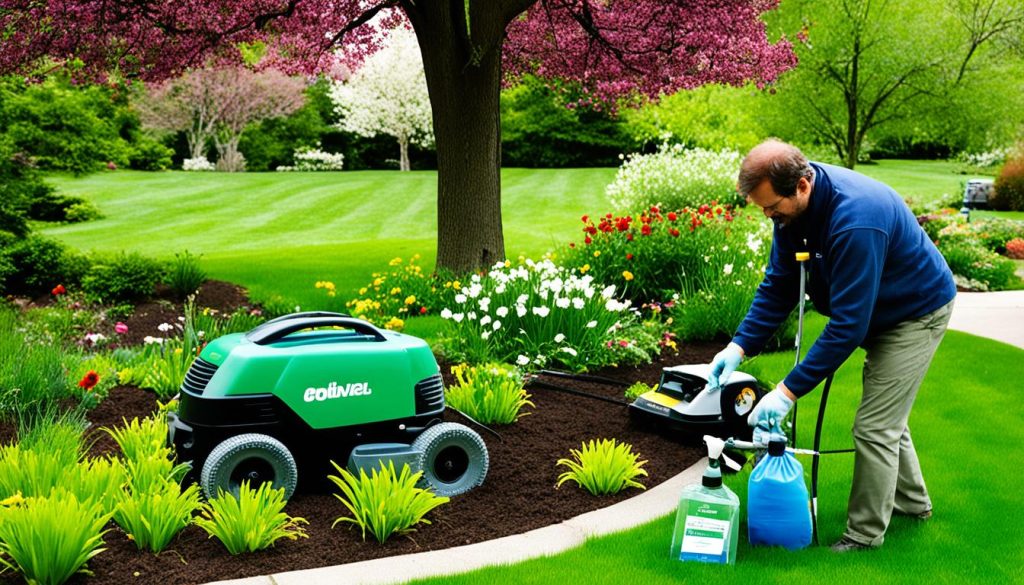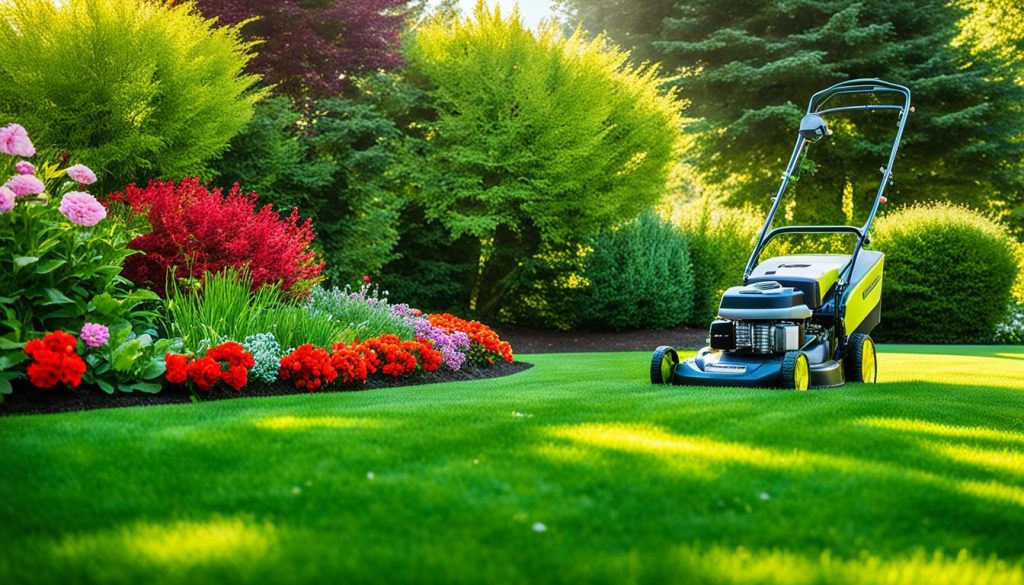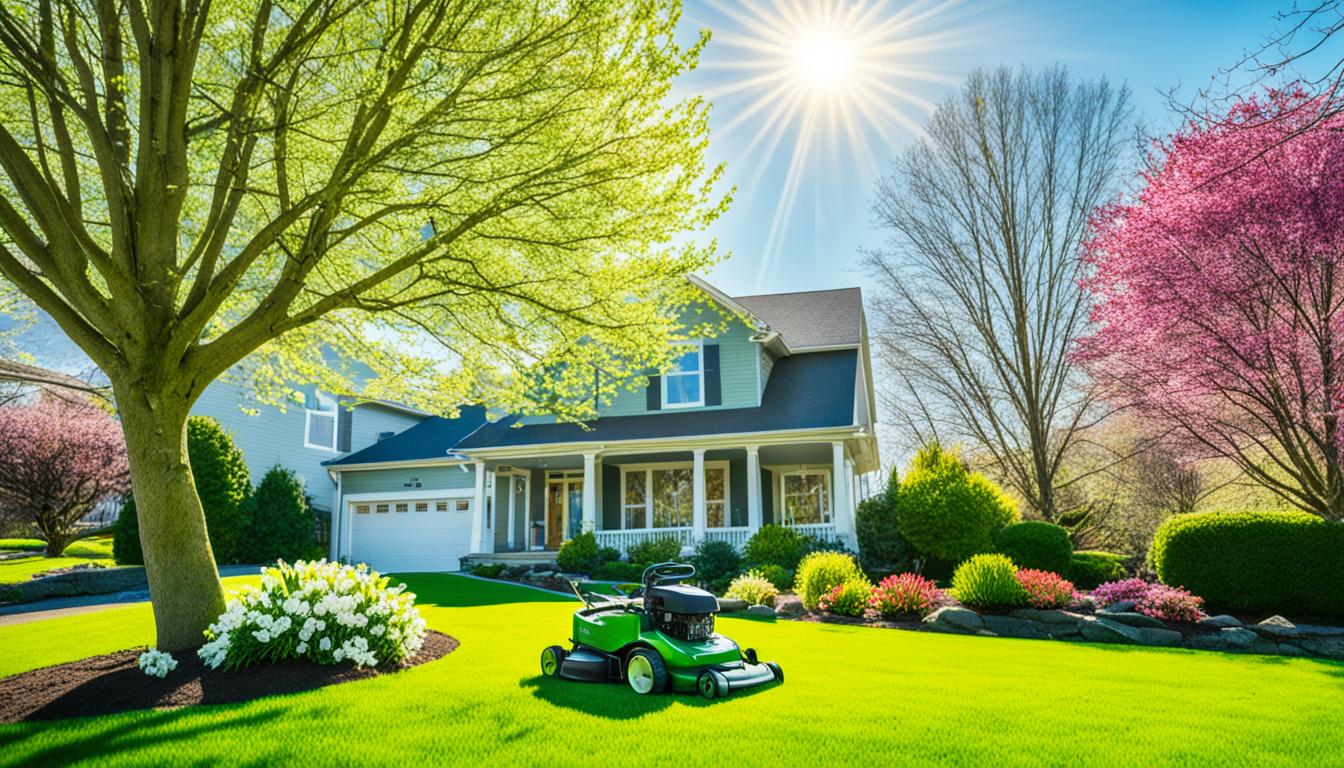Determining the optimal time to mow your lawn in the spring can be tricky. Should you start when the snow melts or wait until the temperatures rise? Are there specific weather conditions to consider? Let’s uncover the answers to these questions and more as we delve into the best practices for mowing your lawn in the spring.
Key Takeaways:
- Wait until temperatures consistently reach at least 40 degrees Fahrenheit to avoid damaging the grass.
- Mow when the grass is dry to prevent clumping and mower clogging.
- Understand the proper grass height, aiming for around 2″ to 2.5″ after cutting.
- Consider factors such as sharpening lawnmower blades, dethatching, and general spring cleanup before mowing.
- Choose the right weather conditions for mowing, aiming for sunny or dry days.
Factors to Consider Before Mowing
Before you start mowing your lawn in the spring, there are a few factors to consider. Firstly, it is important to sharpen your lawnmower blades to ensure a clean cut and prevent tearing of the grass. Dull blades can leave the grass vulnerable to disease. Additionally, consider dethatching your lawn to break up dead grass and allow oxygen and water to reach the roots. Performing a general spring cleanup by removing leaves and debris can also prevent disease and create a healthier lawn.
If you’re not ready to mow when your lawn is, you can reach out to lawn care professionals who can assist you with lawn maintenance and provide landscaping services.
Sharpen Your Lawnmower Blades
Sharpening your lawnmower blades is a crucial step in preparing for the spring mowing season. Dull blades can tear the grass instead of providing a clean cut, which can weaken the grass and make it more susceptible to diseases. By sharpening the blades, you ensure a precise cut that promotes healthy grass growth.
Dethatch Your Lawn
Dethatching your lawn involves removing the layer of dead grass and debris that accumulates between the healthy grass and the soil. This layer, known as thatch, can prevent oxygen, water, and nutrients from reaching the roots of the grass. By dethatching, you create a healthier environment for your lawn’s growth and reduce the risk of diseases.
Perform a Spring Cleanup
A thorough spring cleanup is essential for maintaining a healthy lawn. Removing leaves, branches, and other debris from your lawn not only improves its appearance but also prevents diseases and pests. It allows the grass to receive proper sunlight and airflow, promoting healthy growth and minimizing the risk of fungal infections.
If you’re not ready to mow when your lawn is, you can reach out to lawn care professionals who can assist you with lawn maintenance and provide landscaping services.
Best Weather Conditions for Mowing
When it comes to mowing your lawn in the spring, the weather conditions play a crucial role. Choosing the right time and weather conditions can ensure optimal results. Here are some tips to help you determine the best weather conditions for mowing:
- Mow when it is sunny or when the ground is dry. Mowing wet grass after rain can lead to clumps and potential damage to your lawn.
- Wait until the grass has dried out before mowing. This will help prevent clumping and allow for a clean and even cut.
- Consider mowing in the early evening. During this time, the grass has received sufficient sunlight, and the shade provided in the evening helps the grass to heal.
Mowing your lawn in the optimal weather conditions can contribute to the overall health and appearance of your lawn in the spring.
| Weather Conditions | Benefits |
|---|---|
| Sunny and dry | Avoids clumping and potential damage to the lawn |
| Grass has dried out | Prevents clumping and allows for a clean and even cut |
| Early evening | Provides sufficient shade for the grass to heal |
Dealing with Cold or Frosty Conditions
When it comes to mowing your lawn in the spring, it’s crucial to take into account the unpredictable weather conditions, particularly cold or frosty conditions. To ensure the health and integrity of your lawn, it’s recommended to wait until temperatures have consistently remained above 40 degrees Fahrenheit before attempting the first mow of the season.
Mowing frost-covered or frozen grass can cause significant damage to your lawn, potentially even killing the grass. It’s better to err on the side of caution and wait until the conditions are favorable for mowing.
Benefits of Waiting for Favorable Conditions:
- Prevents damage to the grass
- Safeguards the overall health and vitality of the lawn
- Avoids potential lawn reconstruction or reseeding
| Conditions | Action |
|---|---|
| Cold or frosty | Wait until temperatures consistently remain above 40 degrees Fahrenheit |
| Dry and warm | Begin mowing when favorable weather conditions arise |
| Wet or rainy | Avoid mowing until the grass has dried out |
Fertilizing and Watering Your Lawn
Along with mowing, fertilization and watering are important aspects of spring lawn care. Fertilizing in the spring can help green up the grass and promote healthy growth. It is recommended to apply an appropriate amount of lawn fertilizer based on your region and grass type.
Table: Recommended Lawn Fertilizer Application Rates
| Grass Type | Region | Fertilizer Application Rate |
|---|---|---|
| Kentucky Bluegrass | Midwest | 1 pound per 1,000 square feet |
| Bermuda Grass | Southern | 1/2 pound to 1 pound per 1,000 square feet |
| Tall Fescue | Mid-Atlantic | 1 to 1.5 pounds per 1,000 square feet |
Additionally, watering your lawn properly is crucial for a lush and healthy appearance. The amount and frequency of watering depend on various factors such as soil moisture, grass type, and region. Generally, watering in the early morning is recommended to minimize water evaporation, while avoiding nighttime watering to prevent the growth of harmful fungi.
Note: Adjust the watering schedule based on the specific needs of your lawn.

By following a proper fertilization and watering routine, you can ensure the vitality of your lawn during the spring season.
Determining Grass Height
Understanding the proper height for cutting grass is essential for maintaining a healthy lawn. In the spring, it is advisable to wait until the grass is at least 2 inches tall before mowing. This allows the grass to develop strong roots and withstand the stress of mowing. Additionally, it is important to avoid cutting off more than one-third of the grass height in a single mowing. For cool-season grasses, such as those commonly found in Minnesota, the ideal height after cutting is around 2″ to 2.5″. By following these guidelines, you can ensure optimal grass health and growth.
| Grass Type | Ideal Height after Cutting |
|---|---|
| Cool-season grasses | 2″ to 2.5″ |
Timing Considerations for Overseeding
Overseeding is a common practice in the spring to promote thicker and healthier lawns. However, timing is crucial when it comes to overseeding and mowing to ensure the best results. It is generally recommended to overseed before fertilizing, allowing for a well-coordinated schedule of seeding, mowing, and fertilizing without causing damage to the grass.
To achieve successful overseeding, it is often advisable to wait until later in spring, around April to May, before starting the mowing process. This timing allows the newly introduced grass seeds to establish themselves and grow without interference from the mower. By carefully coordinating the timing of overseeding and mowing, you can improve the density and appearance of your lawn, resulting in a lush and vibrant landscape.
| Task | Timing |
|---|---|
| Overseeding | April to May |
| Mowing after overseeding | Late spring (April to May) |
Impact of Freezing Conditions on Mowing
In spring, freezing conditions can present challenges for lawn care. The alternating cycle of freezing and thawing can be harsh on new grass growth and lead to dehydration, which can be detrimental to the health of your lawn. To protect your grass from potential frost damage, it is recommended to adjust your mowing height slightly longer than usual if freezing is a possibility. This precautionary measure ensures that the grass is not cut too short, which could leave it vulnerable to frost damage.
Instead of risking harm to your lawn by cutting it too short, it is better to have slightly longer grass that may require more frequent mowing. This will promote healthier growth and minimize the impact of freezing conditions on your lawn. By taking this simple step, you can maintain the integrity and beauty of your yard throughout the spring season.
| Impact of Freezing Conditions on Mowing | Recommended Action |
|---|---|
| Freezing and thawing cycle can be harsh on new grass growth | Adjust mowing height slightly longer than usual |
| Dehydration due to freezing conditions | Protect grass from potential frost damage |
| Risk of cutting grass too short | Prevent harm to the lawn |
| Slightly longer grass requires more frequent mowing | Promote healthier growth and minimize the impact of freezing conditions |
By following these spring lawn care tips and being mindful of freezing conditions, you can ensure that your lawn remains healthy and resilient throughout the season.
Considering Wet Conditions
Spring often brings periods of heavy rainfall, resulting in wet lawn conditions. Mowing wet grass can be challenging and potentially detrimental to the lawn. It is important to pay close attention to weather conditions and refrain from mowing until the grass has dried out. Wet grass can clump, clog the mower, and create difficulties in achieving a clean cut. It is advisable to adjust the mowing schedule accordingly to prevent potential problems or damage to the turf.
Alternative Lawn Care Tasks
While waiting for the grass to dry out, there are other important lawn care tasks that can be carried out. Here are a few options:
- Trimming edges: Use a grass trimmer to tidy up the edges of the lawn, creating a neater appearance.
- Weeding: Take advantage of the wet conditions to remove weeds from the lawn by hand or using an appropriate tool.
- Cleanup: Use this time to clear any debris or fallen leaves from the lawn, preventing them from obstructing future mowing sessions.
By focusing on these alternative tasks, you can continue to care for your lawn even during wet conditions, ensuring it remains healthy and well-maintained.
Allocating Time for Regular Mowing
Once you have initiated the first mow of the spring, it is important to maintain a regular mowing schedule. To achieve a neat and manicured look, mowing every 3-5 days is often recommended. By allocating the necessary time and energy for regular mowing, you can ensure a well-maintained lawn throughout the spring season.
Regular mowing is essential for promoting healthy grass growth and maintaining the overall appearance of your lawn. It helps prevent the grass from becoming overgrown, which can lead to a dull and unkempt look. By mowing on a consistent schedule, you can keep your lawn looking lush and vibrant.
Lawn Mowing Tips for Spring:
- Set aside dedicated time for mowing your lawn regularly.
- Mow every 3-5 days to ensure proper maintenance.
- Adjust your mowing frequency based on the growth rate of your grass.
- Keep your lawnmower well-maintained and blades sharp for a clean cut.
- Vary the mowing pattern to prevent the grass from leaning in one direction.
- Dispose of grass clippings properly to avoid clumping and lawn damage.
Benefits of Regular Mowing:
- Promotes even growth: Regular mowing ensures that the grass blades grow evenly, resulting in a uniform and well-manicured appearance.
- Prevents weed growth: By mowing frequently, you limit the opportunity for weeds to establish roots and compete with your grass for vital nutrients.
- Improves lawn health: Regular mowing stimulates the growth of new shoots and strengthens the root system, leading to a healthier and more resilient lawn.
- Enhances lawn aesthetics: A well-maintained lawn with consistent mowing creates a visually appealing landscape that adds curb appeal to your home.
By allocating time for regular mowing and following essential lawn mowing tips, you can enjoy a beautiful and well-groomed lawn throughout the spring season.
Importance of Lawn Maintenance
Proper lawn maintenance is crucial for a lush and vibrant yard during the spring. While mowing is an essential aspect, it is equally important to consider other elements of lawn care such as fertilization, watering, and general cleanup. Regular maintenance tasks not only promote healthy grass growth but also help prevent diseases and enhance the overall appearance of your lawn.
By prioritizing lawn maintenance in spring, you can ensure the longevity and beauty of your yard throughout the season. Here are some key reasons why maintaining your lawn is essential:
1. Promotes Healthy Grass Growth
- Regular mowing stimulates the growth of new grass blades and promotes lateral spreading, resulting in a thicker and denser lawn.
- Fertilization provides essential nutrients to the grass, encouraging strong root development and overall health.
- Overseeding helps fill in bare patches and promotes the growth of new grass in thin areas.
2. Prevents Diseases
- Regular mowing at the appropriate height reduces the risk of fungal diseases by improving air circulation and sunlight penetration.
- Proper watering techniques and drainage practices help prevent waterlogged conditions that can lead to various lawn diseases.
- Removing debris and keeping the lawn clean prevents the buildup of pathogens and pests, minimizing the chances of disease outbreaks.
3. Enhances the Overall Appearance
- A well-maintained lawn with neat and even mowing lines creates an aesthetically pleasing visual appeal.
- Regular removal of weeds and unwanted vegetation helps maintain a uniform and manicured look.
- General cleanup, such as clearing leaves and debris, keeps the lawn tidy and enhances its overall appearance.
By investing time and effort in lawn maintenance, you can enjoy a beautiful and well-cared-for yard that becomes the envy of the neighborhood. Whether you choose to maintain your lawn yourself or seek professional assistance, proper care and attention to maintenance tasks will ensure a thriving and stunning lawn throughout the spring season.

Seeking Professional Assistance
If you find the tasks of lawn care overwhelming or lack the time and expertise to properly maintain your lawn, seeking professional assistance is a viable option. Lawn care professionals have the knowledge and experience to provide comprehensive services, including mowing, fertilization, and landscaping. By entrusting your lawn to experts, you can ensure optimal care and achieve the desired results for your spring lawn.
| Benefits of Professional Lawn Care |
|---|
| Expertise and Knowledge |
| Save Time and Effort |
| Quality Results |
| Comprehensive Services |
| Customized Solutions |
| Equipment and Tools |
- Expertise and Knowledge: Lawn care professionals have in-depth knowledge of different grass types, local climate conditions, and optimal care practices. They can assess the specific needs of your lawn and provide tailored solutions.
- Save Time and Effort: Maintaining a lawn requires regular care, which can be time-consuming and physically demanding. By hiring professionals, you can save time and focus on other priorities.
- Quality Results: Professional lawn care providers have the experience and skills to deliver exceptional results. They can ensure a well-manicured lawn that enhances the beauty of your property.
- Comprehensive Services: Lawn care companies offer a range of services, including mowing, fertilization, weed control, and landscaping. They can create a customized plan based on your lawn’s specific needs.
- Customized Solutions: Professionals can assess the condition of your lawn and develop a personalized care plan. They can address specific issues such as thinning grass, weed infestations, or soil imbalances.
- Equipment and Tools: Lawn care professionals have access to advanced equipment and tools that may not be readily available to homeowners. This allows them to efficiently tackle lawn care tasks.
By seeking professional assistance for your lawn care needs, you can enjoy a well-maintained and healthy lawn throughout the spring season. Whether you need occasional help or ongoing maintenance, lawn care professionals can provide the expertise and services required to keep your lawn looking its best.
Conclusion
Taking care of your lawn in the spring requires careful consideration of various factors such as grass growth, weather conditions, and proper maintenance techniques. By following the guidelines outlined in this article, you can determine the best time to mow your lawn, understand the importance of lawn maintenance, and achieve a lush and vibrant yard throughout the spring season.
Remember to monitor the grass height, consider the impact of freezing or wet conditions, and establish a regular mowing schedule. This will help you maintain the health and appearance of your lawn. Additionally, don’t forget to fertilize and water your lawn appropriately to promote grass growth and prevent diseases.
Whether you choose to maintain your lawn yourself or seek professional assistance, investing time and effort into spring lawn care will result in a beautiful and healthy yard. By incorporating these spring lawn care tips into your routine and following the spring lawn care checklist, you can enjoy a thriving and well-maintained lawn all season long.





